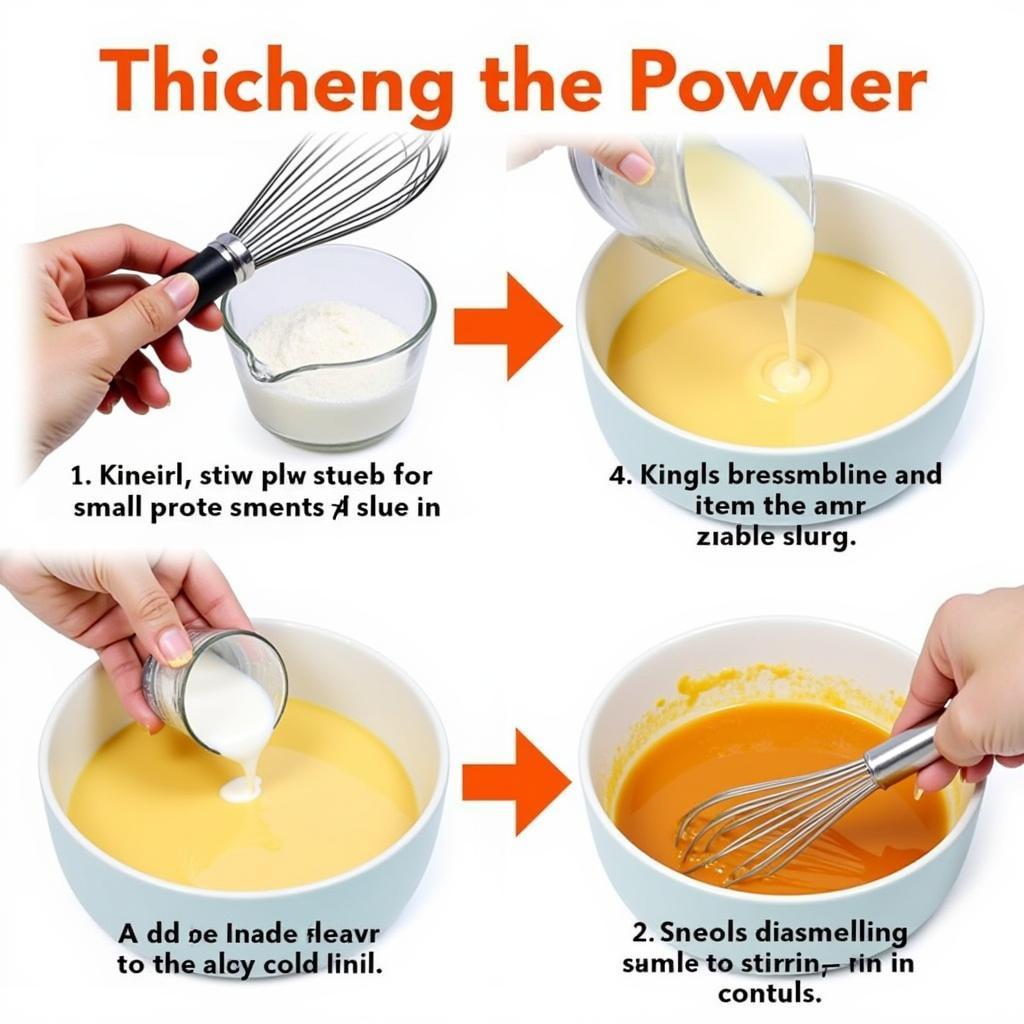Food Thickener Powder is a pantry staple for many home cooks and professional chefs alike. Whether you’re creating a rich gravy, a velvety smooth sauce, or a comforting soup, these versatile powders can transform your culinary creations. This guide dives deep into the world of food thickener powder, exploring different types, their uses, and tips for achieving perfect results every time.
Understanding Food Thickener Powder: Types and Uses
From classic cornstarch to more exotic options like arrowroot powder, there’s a wide range of food thickener powders available. Each type has its unique properties and best applications. Let’s break down some popular choices:
-
Cornstarch: A versatile and affordable option, cornstarch is derived from corn and is excellent for thickening sauces, gravies, puddings, and fruit fillings.
-
Arrowroot Powder: This powder is extracted from the arrowroot plant and creates a clear, glossy finish, making it ideal for fruit sauces and glazes.
-
Tapioca Starch (Tapioca Flour): Derived from the cassava root, tapioca starch adds a slightly chewy texture and is often used in gluten-free baking and Asian cuisine. It’s also an excellent choice for thickening soups and stews.
-
Potato Starch: Extracted from potatoes, this powder is a good choice for thickening soups and stews that need to be reheated, as it maintains its thickening power even after cooling and reheating.
-
Xanthan Gum: A powerful thickener, xanthan gum is produced by fermenting sugar with bacteria. It’s commonly used in gluten-free baking and for thickening sauces and dressings. It’s particularly useful for stabilizing emulsions and preventing separation.
 Properly Using Food Thickener Powder
Properly Using Food Thickener Powder
Choosing the Right Food Thickener Powder
The best food thickener powder for your needs depends on the dish you’re preparing and your desired outcome. Consider these factors:
-
Desired Texture: Do you want a smooth, glossy finish or a more opaque, hearty texture? Arrowroot powder provides a clear finish, while cornstarch creates a more opaque appearance.
-
Temperature Sensitivity: Some thickeners, like cornstarch, can break down at high temperatures. Arrowroot powder is more heat-stable.
-
Flavor Profile: Some powders can impart a slight flavor to your dish. For example, potato starch can sometimes leave a slightly earthy taste.
-
Dietary Restrictions: If you’re following a gluten-free diet, opt for gluten-free options like tapioca starch, arrowroot powder, or xanthan gum. You may want to explore whole foods custard powder as well.
Tips for Using Food Thickener Powder
To achieve perfectly thickened sauces and gravies, follow these expert tips:
-
Make a Slurry: Always mix the food thickener powder with a small amount of cold liquid (water, broth, or milk) to create a smooth slurry before adding it to the hot liquid you want to thicken. This prevents clumping and ensures even distribution.
-
Add Gradually: Slowly whisk the slurry into the simmering liquid, stirring constantly to prevent lumps.
-
Cook Thoroughly: Most food thickener powders require a brief cooking time to reach their full thickening potential. Simmer for a few minutes after adding the slurry, stirring continuously.
-
Adjust as Needed: If the sauce or gravy is not thick enough, you can add more slurry. If it becomes too thick, thin it out with a little more liquid.
Conclusion: Mastering Food Thickener Powder
Food thickener powder is an invaluable tool for any cook. By understanding the different types, their properties, and proper techniques, you can confidently create delicious, perfectly thickened dishes. For more insights on food additives and their roles, check out our articles on what is stabilizer in food and thickening powder for food. With a little practice, you’ll be a master of using food thickener powder in no time. If you’re considering specialized dietary needs, you might find our resource on puree food for elderly helpful. Or perhaps you’re trying to solve a asian food thickener crossword clue? We’ve got you covered!
FAQ
-
What is the most common food thickener powder? Cornstarch is the most commonly used food thickener powder.
-
Can I use flour as a thickener instead of powder? Yes, but it requires more flour and can result in a cloudy appearance and slightly doughy taste.
-
What is the best food thickener for clear sauces? Arrowroot powder is excellent for clear sauces.
-
How do I prevent lumps when using food thickener powder? Make a slurry by mixing the powder with cold liquid before adding it to the hot liquid.
-
Can I substitute one food thickener powder for another? In some cases, yes, but the results may vary.
-
How do I store food thickener powder? Store in a cool, dry place in an airtight container.
-
Is food thickener powder gluten-free? Many options are gluten-free, including cornstarch, arrowroot powder, and tapioca starch.
For any further assistance, please contact us at Phone Number: 02437655121, Email: minacones@gmail.com or visit us at 3PGH+8R9, ĐT70A, thôn Trung, Bắc Từ Liêm, Hà Nội, Việt Nam. We have a 24/7 customer service team.